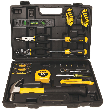Understanding Wallboard Finishing Levels
Written by Lee Wyatt (last updated July 6, 2022)
Have you ever had a contractor, or even a home improvement store clerk, ask you what level of wallboard finishing you want? If you have, and been completely confused by that question, then don't feel too bad. Most home improvement enthusiasts don't know what this means, and those that do only learned because they needed to. Well understanding wallboard finishing levels isn't all that difficult, but it does take a little bit of explanation. Below you will find a brief listing and description of all six finishing levels.
- Level 0. As you can imagine, Level 0 means that absolutely no finishing work has been done at all. The wallboard looks exactly the same as when you put it up, and there is no taping, accessories, or finishing work done at all.
- Level 1. This level is what is used to reference that a minimal amount of finishing work has been done. For example, all the joints of the wall boards, as well as any exposed angles. This type of work is typically shown as there being some joint compound being used, but the excess has been removed. This type of work is usually seen in areas that won't get very much use, such as in service hallways or storage areas.
- Level 2. Level 2 work is where all of the joints, angles, and imperfections have been tapped and covered in joint compound. For the most part this is what most people are used to when they look at "rough" finished wall board.
- Level 3. In addition to the work done in Level 2, Level 3 is required to have all fastener heads, and accessories covered in two separate coats of joint compound. In addition the compound is supposed to be sooth and free of any tool marks and ridges. Over all of this is a coat of wallboard primer.
- Level 4. Level 4 work requires that you have all the work done in the previous levels while also having some light texture or painting work done. Typically gloss, semi-gloss, and enamel paints are avoided at this stage, and only flat paints are used.
- Level 5. As before, this level of work requires that all previous levels also be accomplished before this work is done. In short, this level of work is what most people consider to be a "finished" room. You can now apply any kind of paint that you want, and the room will look complete.
Author Bio
Lee Wyatt
Contributor of numerous Tips.Net articles, Lee Wyatt is quickly becoming a regular "Jack of all trades." He is currently an independent contractor specializing in writing and editing. Contact him today for all of your writing and editing needs! Click here to contact. Learn more about Lee...
Glazing a Wall
If you are looking to decorate your home and don't want to go with the traditional painting or wallpaper, what are your ...
Discover More
Cleaning Makeup Stains from Wool
Many people think that cleaning makeup stains from wool is going to be next to impossible. After all, while cleaning wool ...
Discover More
Evaluating Home Energy Efficiency
For many homeowners, their energy bills are typically the costliest of their ongoing monthly expenses. The first step to ...
Discover More
More Home Improvement Tips
Finding Studs in Walls
Sometimes it's not easy to locate studs since they are mostly concealed behind plaster and other parts of the wall. While ...
Discover More
Finding Load-Bearing Walls
Most people understand that all exterior walls are load bearing, but it is unsafe to assume that all interior walls are ...
Discover More
Hanging Pictures with Style
Everyone can hang pictures on their wall, but not everyone can do it with style. Surprisingly hanging pictures with style ...
Discover More

Comments